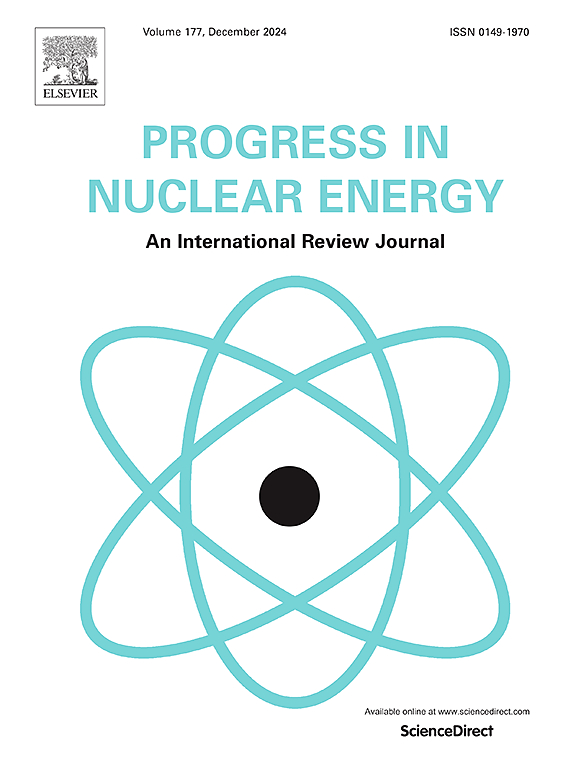Artificial neural network-driven self-calibrating model for thermodynamic analyses of advanced nuclear power plants
IF 3.2
3区 工程技术
Q1 NUCLEAR SCIENCE & TECHNOLOGY
引用次数: 0
Abstract
Research on optimization algorithms for calibrating a generalized thermodynamic model for advanced nuclear reactors is crucial. This study presents an effective method by employing artificial neural networks (ANNs) to calibrate a generalized thermodynamic model and evaluate the thermodynamic performance of advanced reactor-based nuclear power plants under varying weather conditions. Two self-calibrating ANN models were developed specifically for Generation III+ and Generation IV reactors, with each model trained using 10,000 data points. The study identifies that four-layer ANN models with hyperbolic tangent activation functions in the hidden layers yielded superior performance. Among the self-calibration methods evaluated, the Simplex search method outperformed simulated annealing, genetic algorithms, and particle swarm optimization. The ANN models achieved predictive accuracy comparable to simplified models but with significantly reduced self-calibration time, resulting in computational cost savings of 4–5 times. Additionally, the models revealed that Generation IV reactors experienced a 13.54–28.24 % lower efficiency decrease compared to Generation III+reactors when condenser pressure increased from 4 kPa to 7 kPa, indicating that Generation IV reactors are less sensitive to condenser pressure changes. The development of self-calibrating ANN models with optimized architectures and the comparative analysis of calibration algorithms contribute to more accurate, efficient, and cost-effective thermodynamic performance assessments. The findings provide valuable insights for reactor development and operational strategies regarding plant efficiency in varying weather conditions.
先进核电站热力分析的人工神经网络自校正模型
研究先进核反应堆广义热力学模型标定的优化算法是至关重要的。本文提出了一种利用人工神经网络(ann)标定广义热力学模型并评估先进堆式核电站在不同天气条件下热力学性能的有效方法。两种自校准人工神经网络模型是专门为三代+和四代反应堆开发的,每个模型使用10,000个数据点进行训练。研究发现,在隐藏层中具有双曲正切激活函数的四层ANN模型产生了更好的性能。在评估的自校准方法中,单纯形搜索方法优于模拟退火、遗传算法和粒子群优化。人工神经网络模型达到了与简化模型相当的预测精度,但显著减少了自校准时间,从而节省了4-5倍的计算成本。此外,模型还显示,当冷凝器压力从4 kPa增加到7 kPa时,第四代反应堆的效率下降幅度比第三代+反应堆低13.54 - 28.24%,说明第四代反应堆对冷凝器压力变化的敏感性较低。具有优化架构的自校准人工神经网络模型的开发和校准算法的比较分析有助于更准确,高效和成本效益的热力学性能评估。这些发现为反应堆的发展和在不同天气条件下电厂效率的操作策略提供了有价值的见解。
本文章由计算机程序翻译,如有差异,请以英文原文为准。
求助全文
约1分钟内获得全文
求助全文
来源期刊

Progress in Nuclear Energy
工程技术-核科学技术
CiteScore
5.30
自引率
14.80%
发文量
331
审稿时长
3.5 months
期刊介绍:
Progress in Nuclear Energy is an international review journal covering all aspects of nuclear science and engineering. In keeping with the maturity of nuclear power, articles on safety, siting and environmental problems are encouraged, as are those associated with economics and fuel management. However, basic physics and engineering will remain an important aspect of the editorial policy. Articles published are either of a review nature or present new material in more depth. They are aimed at researchers and technically-oriented managers working in the nuclear energy field.
Please note the following:
1) PNE seeks high quality research papers which are medium to long in length. Short research papers should be submitted to the journal Annals in Nuclear Energy.
2) PNE reserves the right to reject papers which are based solely on routine application of computer codes used to produce reactor designs or explain existing reactor phenomena. Such papers, although worthy, are best left as laboratory reports whereas Progress in Nuclear Energy seeks papers of originality, which are archival in nature, in the fields of mathematical and experimental nuclear technology, including fission, fusion (blanket physics, radiation damage), safety, materials aspects, economics, etc.
3) Review papers, which may occasionally be invited, are particularly sought by the journal in these fields.
 求助内容:
求助内容: 应助结果提醒方式:
应助结果提醒方式:


